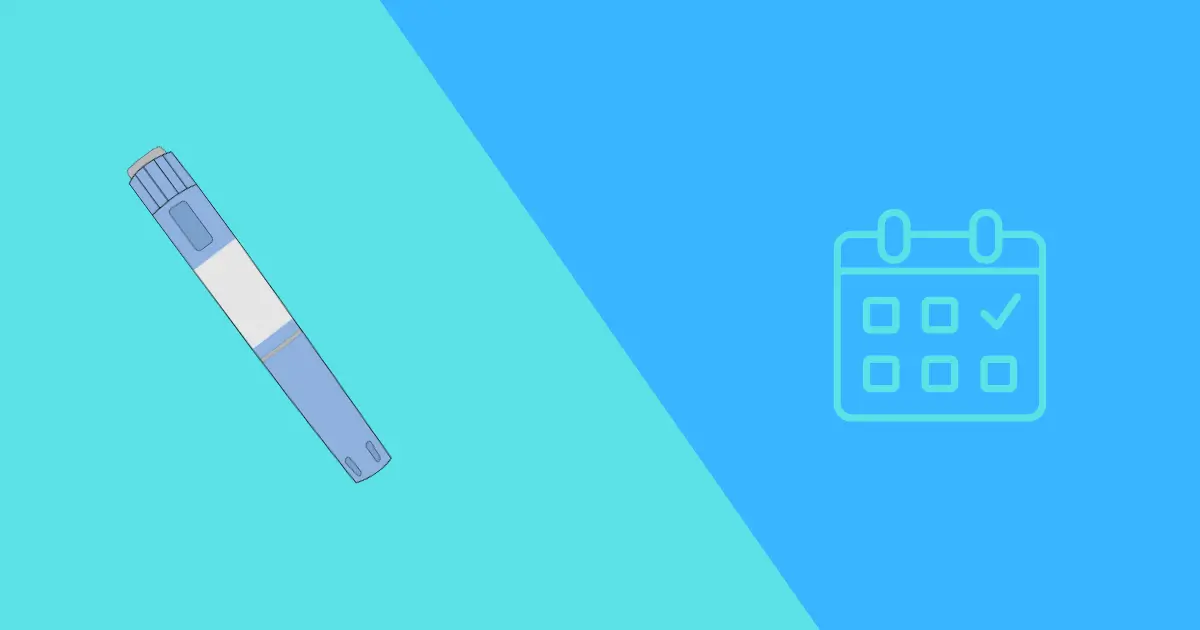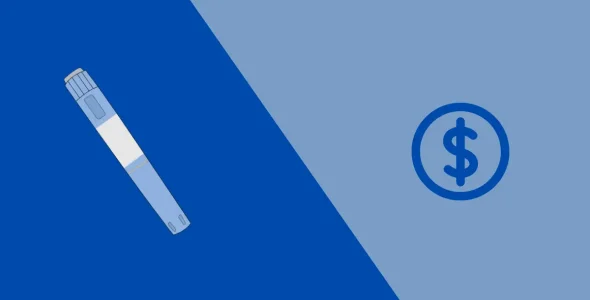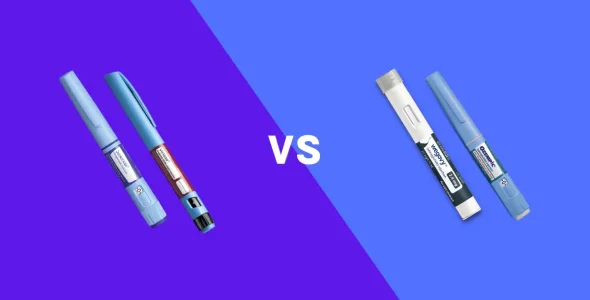How long does it take for semaglutide to work? A complete timeline for weight loss & diabetes
You took your first dose of semaglutide—so why hasn’t the magic happened yet? Before you panic, learn the realistic timeline (and how to make it work faster).
Key highlights
- Semaglutide is an FDA-approved injectable GLP-1 medication available with three brand names (Ozempic, Wegovy and Rybelsus).
- The medication is indicated for managing blood sugar levels (Ozempic and Rybelsus) and weight loss (Wegovy) when combined with a low-calorie diet and exercise.
- Semaglutide may take weeks to months for its full therapeutic effects to kick in, such as appetite suppression in 1-4 weeks, optimized blood sugar control in 1-2 weeks, and weight loss in 4-8 weeks.
- The efficacy of semaglutide varies among individuals and may take time to show visible results. You can speed up the results by following a healthy diet, doing strength training and cardio exercises, and staying hydrated.
Semaglutide is a GLP-1 receptor agonist available in three brand names: Ozempic, Wegovy, and Rybelsus. The FDA-approved use of this medication varies according to the brand names. Ozempic and Rybelsus are FDA-approved for controlling blood sugar levels in patients with type 2 diabetes. Wegovy is FDA-approved for chronic weight management in individuals who are obese (patients with a BMI of 30 or greater) or overweight (BMI 27 or more) with at least one weight-related health condition. Your healthcare provider may also prescribe Ozempic for weight loss (off-label).
Semaglutide is gaining momentum due to its proven benefits in weight loss, blood sugar control, kidney disease, and reducing the risk of cardiovascular events. The popularity of semaglutide has exploded on various social media platforms like Facebook, YouTube, Instagram, and TikTok, where people share their weight loss and sugar control journeys. Many celebrities are also using this medication for weight loss purposes.
A common question that may pop up in your mind while starting this medication is: How long does it take for semaglutide to work? Semaglutide starts working in your body soon after starting the medication. However, the visible results take time, and it’s not an overnight process. You may experience appetite suppression within 1-4 weeks, blood sugar control in 1-2 weeks, and weight loss results in 4-8 weeks. However, the results vary from person to person. Semaglutide is a long-term tool for managing blood sugar levels and body weight, instead of a miraculous drug that works overnight
In this article, you will learn about the science behind semaglutide, a detailed timeline for both weight loss and blood sugar control, factors influencing results, how to monitor the progress, and the critical role of your healthcare provider.
Understanding semaglutide
Semaglutide is a GLP-1 receptor agonist approved by the U.S. Food and Drug Administration (FDA). It is available under the following brand names: Ozempic, Wegovy, and Rybelsus. Each brand name has different indications, uses, and dosage regimes.
Ozempic is an injectable FDA-approved medication that is injected subcutaneously (under the skin) once weekly. The FDA-approved uses of this medication include:
- Controlling blood sugar levels in patients with type 2 diabetes mellitus when combined with healthy habits such as a healthy diet and exercise.
- Reducing the risk of worsening kidney diseases in patients with chronic kidney disease (CKD) and type 2 diabetes mellitus.
- Reducing the risk of cardiovascular events such as stroke, non-fatal myocardial infarction, or stroke in patients with or without type 2 diabetes mellitus.
Rybelsus comes in oral form and is FDA-approved for managing blood sugar levels in adults with type 2 diabetes mellitus when combined with a healthy diet and exercise.
Wegovy is an injectable medication that is FDA-approved for chronic weight management when taken in combination with a reduced-calorie diet and exercise. Your healthcare provider may recommend this weight loss medication if you are obese (BMI of 30 or greater) or overweight (BMI of 27 or greater) with at least one other weight-related comorbid condition, such as dyslipidemia, hypertension, and high blood cholesterol levels. Wegovy also reduces the risk of major cardiovascular events.
How semaglutide works
Semaglutide works in the following ways in your body:
Mimics GLP-1
Semaglutide has a structure similar to GLP-1 (glucagon-like peptide-1) receptor, which is a natural physiological hormone released from your brain and intestine (L-cells) in response to food. This medication mimics the activity of the GLP-1 hormone, which is responsible for regulating your body’s sugar level and metabolic health. This medication works by stimulating insulin secretion, promoting satiety (feeling of fullness), suppressing glucagon secretion, and delaying gastric emptying.
Appetite suppression
Semaglutide suppresses your appetite by mimicking the activity of GLP-1 receptors in your brain. The medication binds with GLP-1 receptors in your brain (hypothalamus), particularly in the areas responsible for controlling hunger and satiety. Afterwards, it activates these receptors in your brain and promotes a feeling of fullness, delays gastric emptying, and reduces food noise and cravings.
Slowed gastric emptying
GLP-1 medications delay your stomach emptying by relaxing the muscles of your stomach. Semaglutide reduces your gastric motility and also reduces the peristaltic contractions that move food from the stomach to the small intestine. This action prevents spikes in blood sugar levels after eating.
In addition, this medication also suppresses gastric acid secretion and promotes satiety, resulting in appetite reduction. It helps manage blood sugar levels in individuals with type 2 diabetes mellitus.
Insulin secretion (glucose-dependent)
Blood sugar regulation is impaired in individuals with type 2 diabetes mellitus due to either decreased insulin production or the body’s reduced sensitivity to insulin (insulin resistance).
GLP-1 receptors are located in your brain and gut, including the pancreas. Semaglutide binds with the GLP-1 receptor in the pancreas and stimulates insulin secretion in a glucose-dependent manner, which means insulin is only released when the blood sugar level is high.
Glucagon suppression
Glucagon is produced by alpha cells in the pancreas. Semaglutide also inhibits the secretion of glucagon (a hormone that promotes glucose synthesis and releases stored glucose from the liver). Semaglutide reduces glucagon secretion from the alpha cells of the pancreas.
How quickly does semaglutide work? What to expect
Ozempic and Rybelsus are used for blood sugar control in patients with diabetes, and Wegovy is indicated for weight management. Healthcare providers prescribe Ozempic off-label for weight management. Patients typically experience appetite suppression after a few days of starting the medication. However, the visible and measurable effects, such as optimal blood sugar control and weight loss, take time.
Generally, semaglutide improves blood sugar levels after 2-4 weeks and promotes weight loss after 4-8 weeks of starting the medication.
Semaglutide is administered at a low dose initially, and the dosage is increased gradually according to your body’s tolerance. The FDA-approved dosing schedule of semaglutide is as follows:
Wegovy is an injectable medicine that is administered weekly, on the same day each week, regardless of time before or after the meal. This medication is injected subcutaneously in the upper arm, abdomen, or thigh.
The starting dose of Wegovy is 0.25 mg. The medication is started at a low dose to help the body adapt and reduce the risk of side effects. Your healthcare provider will increase the dose every 4 weeks to achieve the maintenance that suits your body.
The FDA-approved dosing schedule for Wegovy is:
- Week 1-4: 0.25 mg dose once weekly for the first 4 weeks (starting dose)/
- Week 5-8: 0.5 mg dose once weekly
- Week 9-12: 1 mg once weekly, if needed
- Week 13-16: 1.7 mg once weekly, if needed
- Week 17 and beyond: 1.7 mg or 2.4 mg (maximum dose)
The initial dose of Ozempic is 0.25 mg, which is injected once weekly for the first 4 weeks. Afterwards, your healthcare provider will titrate the dose gradually every 4 weeks, according to your body’s response.
The FDA-approved dosing schedule for Ozempic is:
- Week 1-4: 0.25 mg dose once weekly for the first 4 weeks (starting dose)/
- Week 5-8: 0.5 mg dose once weekly
- Week 9-12: 1 mg once weekly, if needed
- Week 13 onwards: 2 mg once weekly if further glycemic control is required.
Rybelsus is taken orally 30 minutes before a meal. The Rybelsus dosing schedule is as follows:
- Week 1-4: 3 mg daily for 30 days
- Week 5-8: Increase the dose to 7 mg daily, if additional glycemic control is required
- Week 9-12: 14 mg daily, which is the maximum oral dose of Rybelsus.
Semaglutide timeline for weight loss
Weight loss with semaglutide occurs slowly and gradually. It also depends on how quickly your body responds. Some users may experience faster results, while others may feel little or no progress. However, weight loss typically increases over time with higher doses of semaglutide.
Month 1
Semaglutide reaches peak concentration in 1-3 days after each dose, but the cumulative effect takes time. Initially, you may feel appetite suppression within 1-4 weeks. However, some users also report mild side effects, such as nausea, diarrhea, and vomiting. You may notice reduced hunger, food intake, increased feeling of fullness (satiety), and less “food noise” within the first few days or weeks.
The weight loss is minimal at this stage. According to a clinical trial, semaglutide treatment reduced 2% of body weight after 4 weeks.
Month 2
After 1 month, your healthcare provider will increase the dose from 0.25 mg to 0.5 mg. At this time, the appetite suppression becomes noticeable, and some individuals may experience visible weight loss. In the same clinical trial, users taking semaglutide experienced 4% body weight reduction after 2 months or 8 weeks.
Month 3
At month 3, your healthcare provider may increase the dose to 1 mg once weekly if additional glycemic control or weight loss is required. Participants using semaglutide lost 6% of their body weight after 12 weeks in the same clinical trial.
Month 4
At month 4, your healthcare provider will increase the dose to 1.7 mg to reach the maintenance dose. At this dose, you may experience significant weight loss, enhanced appetite control, and improved overall metabolic health. Clinical trial results show that users lost 8% of their total body weight after 16 weeks of using semaglutide.
Month 5
At this stage, your healthcare provider may also increase the dose up to 2.4 mg (maximum dose) if additional weight loss is required. This can be the long-term maintenance dose if your body can tolerate it. Semaglutide users experience an average weight loss of 8-10% in week 20.
Month 6 and on
After 6 months, you will stay on a maintenance dose. You may also experience a plateau phase, where you will experience no weight loss or minimal weight loss.
The following table details weight loss results with semaglutide, month by month:
Semaglutide weight loss timeline
| Month | Average % weight loss | Notes |
|---|---|---|
| Month 1 | 1–2% | Titration phase, minimal weight loss |
| Month 2 | 3–4% | Dose increases, appetite control |
| Month 3 | 5–6% | Visible weight change for most |
| Month 4 | 7–8% | Stronger therapeutic effect |
| Month 5 | 9–10% | Approaching maintenance dose |
| Month 6 | 10–12% | Results vary, possible plateaus |
STEP 1-8 clinical trials showed the following results:
| Clinical Studies | Time on Semaglutide | Doses Used | Amount of Weight Loss |
|---|---|---|---|
| STEP 1 | 68 weeks | 2.4 mg | 14.9% weight loss vs 2.4% with placebo |
| STEP 2 | 68 weeks | 1 mg and 2.4 mg | 9.6% weight loss vs 3.4% with placebo |
| STEP 3 | 68 weeks | 2.4 mg | 16% weight loss vs 5.7% with placebo |
| STEP 4 | 68 weeks | 2.4 mg | 7.9% weight loss after 20 weeks; those switched to placebo regained 6.9% over 48 weeks |
| STEP 5 | 2 years | 2.4 mg | 77% of semaglutide users lost ≥5% of body weight vs 34% with placebo |
| STEP 6 | 68 weeks | 1.7 mg, 2.4 mg | 13.2% weight loss with 2.4 mg; 19.6% weight loss with 1.7 mg |
| STEP 8 | 68 weeks | 2.4 mg | 15.8% weight loss with semaglutide; 6.4% weight loss with liraglutide |
| STEP UP Phase 3B | 72 weeks | 2.4 mg, 7.2 mg | 20.7% weight loss with 7.2 mg; 17.5% weight loss with 2.4 mg |
| Mayo Clinic Study | 28 weeks | 1 mg, 2.4 mg | 7% weight loss with 1 mg; 9.6% weight loss with 2.4 mg |
Semaglutide timeline for diabetes
Improvement in blood sugar levels occurs gradually over time and with dose escalation. Full therapeutic effects of semaglutide are typically seen with maintenance doses (0.5 to 2 mg of Ozempic and 14 mg of Rybelsus) after 12-20 weeks.
Month 1
In the first month, the starting dose of semaglutide is 0.25 mg (Ozempic) and 3 mg (Rybelsus). These low doses help your body adjust and reduce the risk of possible gastrointestinal side effects such as nausea, vomiting, diarrhea and constipation. According to a clinical study, users taking 1 mg semaglutide experienced a 0.6 % HbA1c reduction from the baseline (8.28%), and fasting blood glucose was 7.8 mmol/L from the baseline (9.6 mmol/L) in the first 4 weeks.
Month 2
In the same clinical study, users taking 1 mg semaglutide experienced improvement in their glycemic control and significant appetite reduction, leading to weight loss. Users experienced a 0.9% drop in HbA1c level, and the fasting glucose level reduced to 7.0 mmol/L from baseline (9.6mmol/L) after 8 weeks.
Month 3
After 12 weeks or 3 months, users experienced a 1.1% drop in HbA1c level, and fasting blood glucose levels dropped to 6.6 mmol/L from a baseline of 9.6 mmol/L.
Month 4
Patients experienced a significant improvement in HbA1c level (reduction of 1.2%) from the baseline (8.28%), and fasting blood glucose level decreased further to 6.4 mmol/L from the baseline (9.6 mmol/L).
Month 5
After 5 months, a reduction in HbA1c level was 1.3 % and the fasting glucose levels were 6.3 mmol/L compared to the baseline (9.6 mmol/L).
Month 6 and on
At month 6, users experienced further improvement in their HbA1c level (1.4% reduction), and fasting glucose levels were 6.2 mmol/L, much lower than the baseline (9.6 mmol/L).
The following table shows the average reduction in HbA1c and fasting glucose levels over time with semaglutide:
| Week | Change in HbA1c (%) | Notes |
|---|---|---|
| 4 weeks | 0.60% | Initial drop in A1c begins |
| 8 weeks | 0.90% | Continued improvement |
| 12 weeks | 1.10% | Rapid reduction maintained |
| 16 weeks | 1.20% | Approaching stabilization |
| 20 weeks | 1.30% | Near maximum effect |
| 24 weeks | 1.40% | Full effect at 6 months |
| Baseline | 9.4 mmol/L | – | Starting level before treatment |
|---|---|---|---|
| Week 4 | 7.8 mmol/L | ↓ 1.6 mmol/L | Rapid initial reduction |
| Week 8 | 7.0 mmol/L | ↓ 2.4 mmol/L | Continued improvement |
| Week 12 | 6.6 mmol/L | ↓ 2.8 mmol/L | Approaching normal range |
| Week 16 | 6.4 mmol/L | ↓ 3.0 mmol/L | Further gradual decline |
| Week 20 | 6.3 mmol/L | ↓ 3.1 mmol/L | Stabilizing effect |
| Week 24 | 6.2 mmol/L | ↓ 3.2 mmol/L | Maintained improvement at 6 months |
Long-term semaglutide treatment provides the following benefits:
- Semaglutide supports sustained weight loss over the long term, helping individuals maintain a healthier body weight.
- The medication promotes glycemic control in patients with type 2 diabetes.
- Semaglutide reduces the risk of heart disease by improving cardiovascular outcomes and lowering the incidence of major cardiac events.
- It may lower the risk of Alzheimer’s disease due to its neuroprotective effects.
- Semaglutide helps reduce systemic inflammation by decreasing levels of C-reactive protein (CRP).
- This medication prevents kidney failure by slowing the progression of chronic kidney disease in patients with type 2 diabetes.
- Semaglutide improves overall metabolic health by enhancing insulin sensitivity and improving lipid profiles.
- It may help reduce the risk of certain obesity-related cancers through weight loss and metabolic regulation.
- Semaglutide improves blood pressure by supporting weight loss and vascular health.
Factors that influence how fast semaglutide works
Semaglutide does not work the same for everyone. Various factors influence how fast semaglutide works:
Consistency with treatment
Semaglutide does not show results within a few hours or days. You have to stay consistent to get full therapeutic benefits. Missing or skipping doses can delay the effects. Therefore, make a schedule and set a reminder for every week to administer the semaglutide injection and consult with your healthcare provider if you miss a dose.
Dosage and titration schedule
The effect of semaglutide is dose-dependent. Higher doses (e.g Wegovy 2.4 mg) may work faster than lower doses. According to a clinical trial, individuals using semaglutide at higher doses (1.7 mg and 2.4 mg) experienced 6.9% weight loss after 3 months. In contrast, people taking lower doses of semaglutide (0.25 mg and 0.5 mg) lost 5.9% of body weight after 3 months. However, fast titration is not recommended because it increases the risk of side effects.
Individual metabolism
Semaglutide response also varies among individuals according to their metabolic health. Some have a faster metabolism and tend to metabolize semaglutide faster than others, while others with a slower metabolism may metabolize it more slowly. Patients with slower metabolism may get more benefits from the medication due to increased exposure to semaglutide.
Lifestyle
Semaglutide is approved by the FDA for weight loss and type 2 diabetes mellitus only when combined with a healthy diet, exercise, and good sleep. People who follow these lifestyle changes notice faster results than those with a sedentary lifestyle.
Starting weight and health profile
Higher BMI can also affect your weight loss journey. People with higher BMI (body mass index) or severe insulin resistance may take more time to experience significant weight reduction. In comparison, individuals with slightly high BMI can achieve it earlier or with low doses.
Tips to speed up semaglutide’s effectiveness
The following are tips to speed up the effectiveness of semaglutide.
- Take semaglutide according to your prescription. Never increase or decrease the dose on your own. Strictly follow the dosing schedule to get good results.
- Consult with your dietician to get a personalized diet plan for you. Eat a high-protein and low-glycemic diet that supports your weight loss and improves muscle mass.
- Regular exercises such as strength training and cardio exercises also increase the efficacy of semaglutide by boosting metabolism, enhancing insulin sensitivity and promoting sustainable weight loss.
- Keep yourself hydrated all the time. Drinking water helps with appetite control and digestion.
- Stress management supports hormonal control and reduces emotional eating. Try to manage stress with stress reduction techniques like meditation, yoga, and behavioural therapies.
- Track progress with the help of a journal or app. This will help you identify what is working best for you.
How to know if semaglutide is working
Semaglutide does not provide instant results. However, some signs indicate that semaglutide has started working. These signs are:
- You don’t feel hungry as you used to, food noise is significantly reduced, and cravings for high-carb, sugary and fatty food are also reduced.
- You feel satisfied after eating a small portion of food (feel full sooner). That feeling of fullness lasts longer and helps you stay less hungry between meals (full for longer).
- Weight loss usually starts slowly and gradually after suppression of your appetite. Track your weight every week to check the efficacy of the medication. Usually, losing 1-2 pounds per week is considered a healthy rate for weight loss.
- You may notice improvement in your blood sugar level in 1-2 weeks after starting the medication. This medication will lower not only your fasting glucose level but also the post-meal blood sugar spikes because semaglutide releases insulin when there are high sugar levels in your body.
- You may notice an increase in energy for daily activities and overall well-being.
Your body takes time to adjust to the medication, and results vary from person to person. Some users experience significant weight loss and improved sugar control earlier, while others do not. Semaglutide works efficiently when combined with a low-calorie diet and healthy exercise. Therefore, be patient and stick to your diet plan because this medication may take weeks or months to show visible results.
Frequently asked questions
Why am I not losing weight on semaglutide?
There are several reasons you may not be losing weight on semaglutide. These include the following:
- You have just started the medication; semaglutide takes time to give visible results.
- Your calorie intake is too high.
- You are not engaging in any physical activity, or you have a sedentary lifestyle.
- You have lost your water weight but not fat mass.
- Your dosage is too low to give you the desired results.
- You are skipping the doses.
- Your body is in a plateau phase.
- You are not taking a balanced diet that complements the effect of semaglutide.
Can semaglutide stop working over time?
Yes, semaglutide may stop working or become less effective over time, a phenomenon known as the plateau phase. This phase happens when you have lost some weight, but are no longer losing weight. This happens when your calorie intake and expenditure are equal or the dosage is low. Consult your healthcare provider, as they may need to increase the dosage of semaglutide or advise a few lifestyle changes.
How long does it take for semaglutide to suppress appetite?
Semaglutide starts working soon after administration. However, it may take 1-4 weeks to suppress appetite and lose body weight. The weight reduction and optimal blood sugar control become visible after 4-8 weeks. These effects may vary from person to person depending on their body’s tolerance and lifestyles.
Can I speed up the process by taking more?
No, you cannot take more semaglutide than the prescribed dose to speed up the process. This may cause severe and intolerable side effects. Always consult with your healthcare provider before increasing the dose of semaglutide.
What if I don’t see results after a few months?
If you are not seeing results after a few months of taking semaglutide, consult your healthcare provider and consider the following factors:
- Confirm whether you are on a full therapeutic dose or a low dose. Lower doses are meant for your body to adjust to the medication and lower the risk of common side effects, not for therapeutic purposes.
- Track your calorie intake.
- Ensure that you are physically active and taking a healthy diet that aligns with the weight-reducing effect of the medication.
- Ensure that you are not skipping the doses of semaglutide.
- Discuss with your healthcare provider whether your injection technique is right.
Your doctor may increase the dosage of the medication, suggest dietary modifications, and lifestyle changes.
Will I regain weight if I stop taking semaglutide?
Yes, you may regain weight if you stop taking semaglutide and don’t follow a healthy diet and exercise plan. In a clinical trial, 327 participants found that stopping semaglutide can lead to significant weight regain and reversal of cardiometabolic effects. Participants taking semaglutide once weekly for 68 weeks experienced a 17.3% weight loss from their body weight, while those on placebo lost just 2% of their body weight. After stopping the medication, participants taking semaglutide regained 11.6% of their body weight, and those taking a placebo regained 1.9%, leading to a net weight loss of 5.6% in the semaglutide group and 0.1% in the placebo group.
Is the timeline different for Ozempic, Wegovy, or Rybelsus?
Yes, the timeline is different for Ozempic, Wegovy, or Rybelsus due to the difference in their doses. However, all these brands contain semaglutide as their active ingredient. Ozempic usually improves blood sugar levels in 4-8 weeks and weight loss in 2-4 months. However, Wegovy is given in higher doses, so it may show results earlier once you increase to the highest dose (2.4 mg). Rybelsus is an oral medication and works more slowly than others. This medication usually improves blood sugar levels in 6-8 weeks, along with a mild weight loss effect.
What about compounded semaglutide? Is it the same timeline?
Compounded semaglutide may follow a similar timeline as Ozempic and Wegovy, but its effect may vary due to differences in formulation, quality, and dosing accuracy. Compounded semaglutide is not FDA-approved for blood sugar control or weight loss. Its safety and effectiveness may differ depending on the standard of the compounding pharmacy. Always consult with your healthcare provider before taking compounded semaglutide.
Conclusion: How long does it take for semaglutide to kick in?
Semaglutide is an FDA-approved GLP-1 medication for individuals with obesity and type 2 diabetes mellitus when combined with a healthy diet and exercise. This medication doesn’t provide instant results. Its effects unfold gradually over time.
Some users may experience reduced appetite and improved blood sugar levels within the first few weeks of starting the medication, while others may take more time, depending on their body’s response to the medication. However, significant weight loss and glycemic control become evident after 8-12 weeks of consistent use, and the full effect is seen after 6 months or more. Data from different clinical trials show an average reduction of 1.4%-2% in HbA1c level and an 8-10% in body weight after 30-56 weeks of treatment.
Staying committed to a healthy diet, regular exercise, and a standard dosing schedule can maximize the semaglutide effects. Regular follow-ups with your healthcare provider are also necessary to seek medical advice, continued monitoring, and for safe progression.






